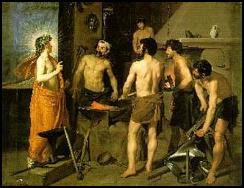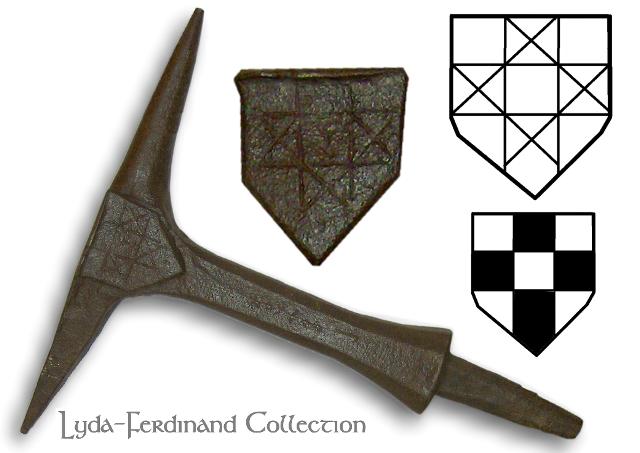Stake anvils or bickerns (beak iron) varied a great bit in weight ranging from very slender to medium to heavy to anvil weight.
This is a medium heavy weight bickern.
Stake anvils and bickerns were common in the era of the hornless anvil.
Hornless anvils were heavy solid blocks used for general forging and bickerns for bending, scrolling and other light work.
 Placing an age on a tool like this is very difficult.
However, this type is seen in paintings from the 15th and 16th Century and the examples of this type all seem to have the same amount of rust pitting indicating a similar age.
In Diego Velazquez's "The Forge of Vulcan" 1630, the stake is identical to the one above.
The subject being of an ancient or earlier time the smithy used for a model was probably an old one.
This would easily place the tools in the 1500's.
Placing an age on a tool like this is very difficult.
However, this type is seen in paintings from the 15th and 16th Century and the examples of this type all seem to have the same amount of rust pitting indicating a similar age.
In Diego Velazquez's "The Forge of Vulcan" 1630, the stake is identical to the one above.
The subject being of an ancient or earlier time the smithy used for a model was probably an old one.
This would easily place the tools in the 1500's.
The Shield is actually a structural part of the stake. It is a reinforcing plate over the T-weld joint.
Besides reinforcing the weld this also creates a slightly larger center work area.
The markings on the shield of this anvil are fairly unique but represent no particular coat of arms and do not fit traditional patterns very well.
In Heraldic tradition this design might be described as
metal a pale colour and fess counterchanged
The metals being silver or gold, the colors red, blue, green, purple and black.
The vertical division being a pale and the horizontal a fess.
It is not a cross because the arms of a cross do not make a square in the center.
The marking in the blocks also do not fit heraldic rules as X's were not used.
So this is probably the blacksmiths idea of a decorated shield
The other outstanding feature of this type stake is the large upset shoulder at the stake.
Only the finest of the stakes were made this way many later ones having a small shoulder or a thin collar welded on.
- Dimensions: Height 25" x Length 22" (635 x 556 m)
- Weight: 50 lbs. (23 kg)









The Shield is actually a structural part of the stake. It is a reinforcing plate over the T-weld joint. Besides reinforcing the weld this also creates a slightly larger center work area.
The markings on the shield of this anvil are fairly unique but represent no particular coat of arms and do not fit traditional patterns very well. In Heraldic tradition this design might be described as
The metals being silver or gold, the colors red, blue, green, purple and black. The vertical division being a pale and the horizontal a fess. It is not a cross because the arms of a cross do not make a square in the center. The marking in the blocks also do not fit heraldic rules as X's were not used. So this is probably the blacksmiths idea of a decorated shieldThe other outstanding feature of this type stake is the large upset shoulder at the stake. Only the finest of the stakes were made this way many later ones having a small shoulder or a thin collar welded on.